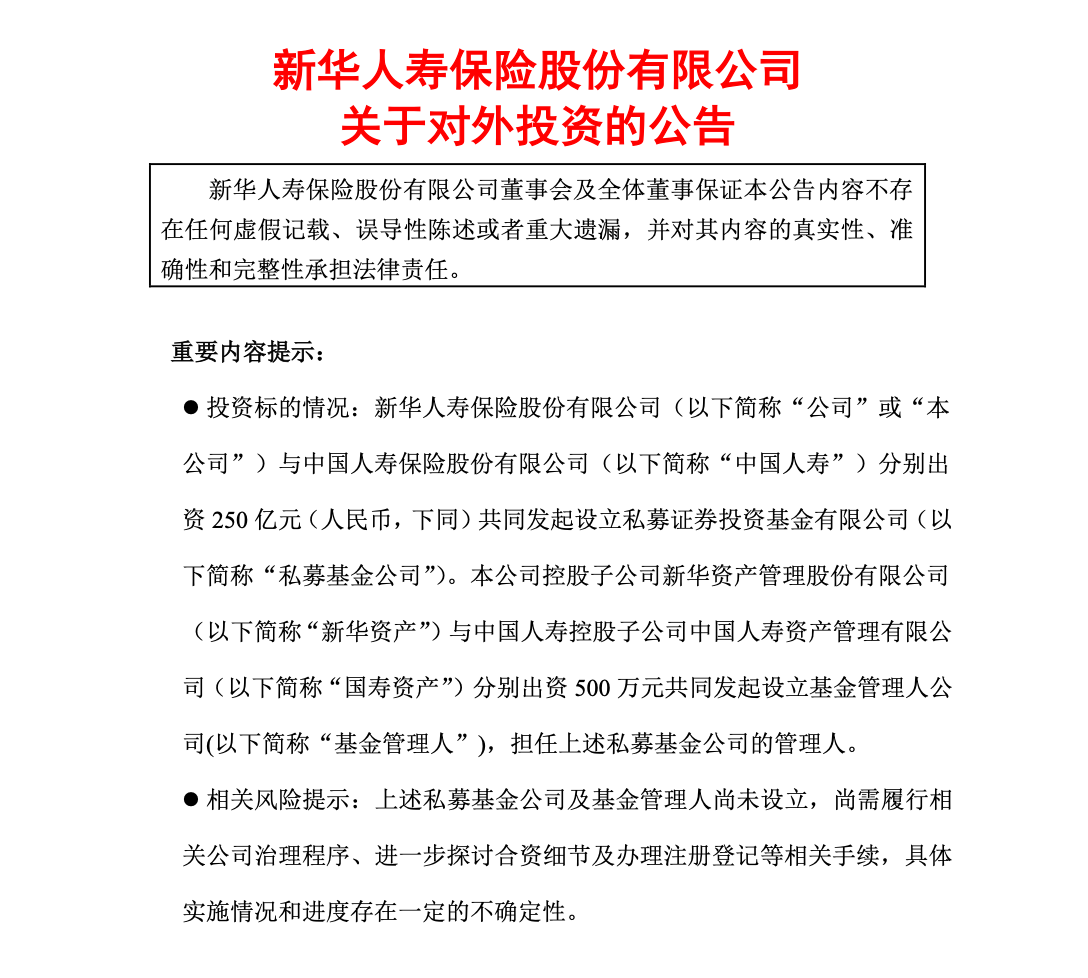CHINA LIFE (China Life Insurance) and NEW CHINA LIFE (Xinhua Insurance) have transformed from peers to partners this time.
On November 29th, China Life Insurance Co., Ltd. (hereinafter referred to as "China Life", 601628. SH, 2628. HK) and Xinhua Life Insurance Co., Ltd. (hereinafter referred to as "Xinhua Insurance", 601336. SH, 1336. HK) respectively announced that they would jointly invest in the establishment of a private securities investment fund. This is the first private equity securities investment fund established by two insurance companies in a joint form in the insurance industry.
The announcements of the two companies show that the private equity securities investment fund is in the form of a company and is tentatively named "Honghu Private Equity Securities Investment Fund Co., Ltd." (subject to final registration approval by the Administration for Industry and Commerce). The planned fundraising scale is RMB 50 billion, with the two companies contributing RMB 25 billion each. The pilot fund has a term of 10+N years, and the initial filing period for the fund is 10 years.
China Life Asset Management Co., Ltd., a subsidiary of China Life Insurance, and Xinhua Asset Management Co., Ltd., a subsidiary of Xinhua Insurance, jointly serve as fund managers for the private equity fund. As the carrier of the fund manager, the company is Guofeng Xinghua Private Equity Fund Management Co., Ltd. (tentative name, ultimately subject to approval and registration by the Administration for Industry and Commerce), which is also contributed equally by the two companies.
China Life Insurance stated that the establishment of this private investment fund, known as the "Huizhi Project" by China Life Insurance, is aimed at further strengthening asset and liability management. Xinhua Insurance stated that it aims to further increase long-term investment assets that are in line with the company's investment strategy, optimize the matching of insurance fund assets and liabilities, and improve the efficiency of fund utilization.
Private equity fund is an important type of private equity fund, mainly investing in publicly traded stocks, bonds, futures, options, fund shares of limited liability companies, as well as other securities and their derivatives regulated by the China Securities Regulatory Commission. Its risk level and return range are lower than those of private equity fund investment projects.
As early as 2015, the former China Insurance Regulatory Commission issued a notice on matters related to the establishment of insurance private equity funds, allowing insurance funds to establish private equity funds, including growth funds, merger and acquisition funds, emerging strategic industry funds, mezzanine funds, real estate funds, venture capital funds, and parent funds with the above-mentioned funds as the main investment objects. However, the private equity funds established by insurance companies at that time did not include private securities funds.
In 2012, the Securities Investment Fund Law was revised, and private securities investment funds were included in the regulatory scope. In 2014 and 2020, the China Securities Regulatory Commission formulated the Interim Measures for the Supervision and Administration of Private Equity Investment Funds and the Several Provisions on Strengthening the Supervision of Private Equity Investment Funds, specifically strengthening the regulatory requirements for private equity funds.
On July 9, 2023, the Regulations on the Supervision and Administration of Private Investment Funds were officially released and will come into effect on September 1, 2023.
The private securities fund jointly established by China Life Insurance and Xinhua Insurance has become the first insurance industry investment fund since the release of the Regulations on the Supervision and Administration of Private Investment Funds.
In April 2023, Guoshou Asset Management Company's managed assets exceeded RMB 5 trillion, becoming the first insurance asset management institution in China to manage assets exceeding RMB 5 trillion.